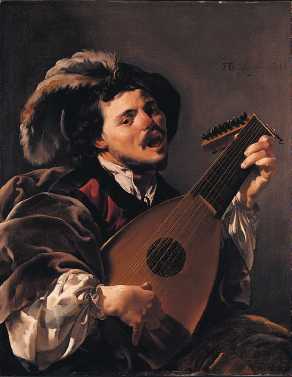
Lute of the Month

Hendrick ter Brugghen (1588 - 1629)
Lute player
1624
National Gallery, London. No. 6347
|
Hendrick ter Brugghen was born in Deventer in the Netherlands and became a pupil of Bloemaert before travelling to Italy for ten years from 1604 - 1614. He returned to the Netherlands in 1616 and settled in Utrecht where he became one of the leading painters of so-called Utrecht school. Some people claim he was heavily inflenced by Caravaggio but apart from some works with strong light and shade contrasts, this doesn't seem to be a very helpful description.
However, if we now look at the nut in this detail, you can equally clearly see eleven courses with ten double and the top single!
Moreover the top nut overhangs the bass edge of the fingerboard in just the way we have come to expect as typical of eleven course lutes. (The classic example of this detail of course is the painting of Mouton in the Louvre.) Also there is a treble rider, which, while not a universal distinguishing feature, does usually go with an eleven rather than a ten course lute.
Hendrick ter Brugghen |
|
Bob Purrenhage has emailed this interesting additional observation about the main picture: "Just an odd observation on the first painting: The detail of the peg head does not show any pointy ends of the treble side pegs passing through to the bass side of the peg head. It hardly looks as though there would be space between the peg tops which we do see on the bass side. So apparently the painter was not really interested in getting the details correct - there and likely elsewhere as well?" |
|
If anyone has any comments about these pictures which differ from or expand
on mine, please do either email me direct or submit them to the lutenet at antispam/lute@cs.dartmouth.edu and I will add them to this page. Do please adjust this address by hand to remove antispam/ |
| Lutes | Bows | |
| History of the Lute | Build your own Baroque Lute | Build your own Renaissance Lute |
Copyright 2000 by David Van Edwards